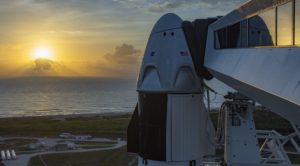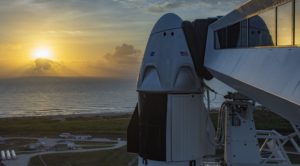
Weather primary concern for Demo-2 launch (Image Credit: SNN)
WASHINGTON — NASA and SpaceX officials said after a final pre-launch review they had no major issues about the upcoming Demo-2 commercial crew launch beyond one over which they have no control: the weather.
NASA concluded a launch readiness review May 25 for the Demo-2 mission, the final pre-launch review for a mission that will send NASA astronauts Bob Behnken and Doug Hurley to the International Space Station on the first crewed flight of SpaceX’s Crew Dragon spacecraft.
That review, officials said during a media telecon after the review, found no major technical issues with the spacecraft or its Falcon 9 rocket. “All the teams are go,” said Kathy Lueders, NASA commercial crew program manager. “Now the only thing we need to do is figure out how to control the weather.”
Forecasts published over the last three days have been pessimistic, with only a 40% chance of acceptable weather for the launch at 4:33 p.m. Eastern May 27. Mike McAleenan, launch weather officer for the 45th Weather Squadron, said at the briefing that a “dynamic situation” had been unfolding over the last few days, including heavy rains at the Florida launch site the day of the review.
However, the forecast for launch day was improving. “Certainly it’s been trending better over the last day or two for launch weather,” he said, concluding that the next forecast will project a 60% chance of acceptable weather.
That forecast, though, only addresses launch conditions. It does not include other factors like upper-level winds, conditions at the booster recovery site, and weather at abort locations should the Crew Dragon have to escape its launch vehicle and come down somewhere along the east coast of North America or even in the North Atlantic Ocean.
The launch forecasts have not provided an estimate of abort conditions, a complicated procedure given that more than 50 potential abort landing locations are considered. “We provide some guidance and some weather parameters to the SpaceX team, and they calculate the probability of all those abort points,” McAleenan said.
“We have a really complicated way of weighing different locations depending on how much risk they have in terms of an escape,” said Hans Koenigsmann, vice president of build and flight reliability of SpaceX. He said a weather briefing during the launch readiness review had about 65 slides and took an hour to go through. “It’s a lengthy process to get to the best result.”
Neither NASA nor SpaceX have specified how many abort sites must have acceptable weather for a launch to proceed. A NASA fact sheet about launch weather criteria merely states that a launch would not proceed “if downrange weather shows a high probability of violating limits at splashdown in case of Dragon launch escape.”
Should weather or other problems scrub the May 27 launch attempt, the next opportunities are May 30 and 31. Weather looks more favorable those days, McAleenan said, although Koenigsmann said those dates would fly a different trajectory that would take 31 hours to get to the station, versus 19 hours for the May 27 launch.
Other launch preparations are going well. Lueders said the Falcon 9 static-fire test on May 22, part of standard pre-launch preparations for any Falcon 9 mission, went as planned, as did a “dry dress” rehearsal May 23 that served as a walk-through for Behnken and Hurley, who put on their pressure suits and boarded the spacecraft on the launch pad.
“For me, this was a little bit of a turning point,” Koenigsmann said of observing that dress rehearsal. “You see people going into that rocket, that is something special. Dragon wasn’t in a training center or someplace else on the ground. This was on the rocket. That’s a big deal, it had a big impact on everybody.”
While noting that there are uncertainties inherent in any new spacecraft, especially one designed to fly people, he added he was confident overall. “I’m at the point right now where I’m actually worried about the weather, and that’s a good sign.”
– Advertisement –









